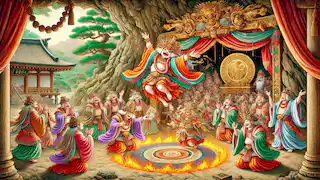The Tale of Amaterasu
Reading Time: 11 min

About Story: The Tale of Amaterasu is a Myth from japan set in the Ancient. This Dramatic tale explores themes of Courage and is suitable for All Ages. It offers Cultural insights. A mythic journey of light, darkness, and the balance of the world.
In the ancient mythology of Japan, the creation of the world and the balance of life revolved around a pantheon of gods and goddesses who ruled the heavens, the seas, and the earth. Among these deities, one stood out as the most revered and powerful—Amaterasu Ōmikami, the radiant goddess of the sun. She was the source of all life, prosperity, and warmth in both the heavens and the earth below. Her light symbolized purity, wisdom, and order, and her story became one of the central myths in Japanese culture, influencing the lives of gods and mortals alike.
But even within the celestial domain of Takamagahara, home to the gods, peace was not always guaranteed. The world of the divine mirrored that of the mortal realm, filled with challenges, conflicts, and the occasional clash of wills. The tale of Amaterasu is as much a story of resilience and harmony as it is a story of conflict and reconciliation, especially between her and her younger brother, Susanoo, the god of storms and seas.
Their rivalry and ultimate reconciliation would define not only the fate of the heavens but also the balance of nature in the world below. It was through their trials and their eventual understanding that light and darkness, creation and destruction, found their delicate equilibrium in the universe. In the sacred realm of Takamagahara, a place high above the mortal world, resided the mighty gods and goddesses who shaped the destiny of the universe. Takamagahara was a place of breathtaking beauty—its skies were vast and endless, filled with the golden light of Amaterasu's sun. The rivers that flowed through its valleys were pure and clear, nourishing the abundant life that thrived there. The mountains stood tall and majestic, their peaks often kissed by the warm glow of the morning sun. Amaterasu ruled this divine domain with grace and wisdom. The other gods revered her, not only for her radiance but also for her deep compassion and leadership. Under her care, the heavens flourished, and peace reigned supreme. But not all the gods shared this peace. Amaterasu's younger brother, Susanoo, god of storms and seas, was a force of nature. His power was raw, wild, and often destructive. Where Amaterasu brought light and order, Susanoo brought chaos and upheaval. His tempests would rage across the heavens and the seas below, causing devastation to both gods and mortals. Although his power was necessary for the balance of the world—bringing rain and fertility—his reckless actions often brought suffering. Susanoo was deeply envious of Amaterasu's influence and the reverence she commanded among the gods. He believed his power over the storms and seas made him just as important, if not more so. But while the gods adored Amaterasu for her steady hand and nurturing light, they often feared Susanoo's temper and unpredictability. This growing envy began to fester in Susanoo's heart, leading to resentment towards his sister. Over time, his anger swelled like one of his great storms, until one fateful day, he could contain it no longer. Deciding that he could no longer live in Amaterasu’s shadow, Susanoo declared his intention to confront her. His storms grew stronger as he prepared to challenge her authority, believing that he could prove his power was just as essential as the sun’s light. In a fit of fury, Susanoo descended upon Takamagahara, his arrival heralded by violent winds and rolling thunderclouds. As he approached Amaterasu’s palace, the very earth trembled beneath his feet, and the skies darkened, obscuring the golden light that usually bathed the realm. Susanoo’s actions were reckless and destructive. In his anger, he began to lash out at everything that symbolized Amaterasu’s influence. First, he trampled through her sacred rice fields, destroying the crops that she had nurtured so carefully. These fields were not just a symbol of Amaterasu’s power, but they were also essential for feeding the gods and maintaining the cycle of life. To destroy them was a direct attack on everything she stood for. As his fury grew, Susanoo stormed through Amaterasu’s palace, shattering its walls and desecrating the sanctity of her domain. The final straw came when Susanoo, in a mad rage, threw a flayed horse—the most sacred of animals to Amaterasu—into her weaving hall. The horse's body crashed through the roof, causing the palace’s structure to tremble. Inside, Amaterasu’s maidens, who were busily weaving the divine garments of the gods, were horrified. In the chaos, some of the maidens were injured or killed by the falling debris. This sacrilege was too much for Amaterasu to bear. Not only had her brother shown complete disrespect for her authority, but he had also caused the deaths of her loyal attendants and desecrated her sacred space. Overwhelmed by grief, sorrow, and anger, Amaterasu withdrew from the world. She retreated into the depths of Ama-no-Iwato, the Heavenly Rock Cave, sealing herself away from the outside world. Inside the cave, Amaterasu shut herself off from everyone and everything. She refused to emerge, and as a result, her radiant light disappeared from the heavens. The sun, once bright and warm, was now gone, plunging both the celestial realm and the earth into total darkness. With Amaterasu hiding in the cave, the world fell into chaos. The darkness that enveloped both Takamagahara and the earth below was profound and terrifying. Without the sun, crops withered, rivers froze, and the land became barren. The once-vibrant life on earth began to fade, and despair spread across the land. Even the gods were powerless without Amaterasu’s light. In the heavens, the gods of Takamagahara convened an emergency council. They knew that without Amaterasu, the world would be doomed. Her light was essential for life itself, and without it, both the divine and mortal realms would wither and die. The gods deliberated for days, trying to devise a plan to bring Amaterasu out of the cave. But nothing seemed to work. They knew they could not force her out—Amaterasu was too powerful and too determined. She had sealed herself away not out of weakness, but out of grief and anger. The gods would need to coax her out, to remind her of the joy and beauty that she brought to the world. It was then that the goddess of mirth and joy, Ame-no-Uzume, came forward with an idea. Uzume was known for her playful and joyous nature, and she believed that only through laughter and celebration could they entice Amaterasu to return. The other gods, though skeptical, agreed to give Uzume’s plan a chance. They gathered outside the entrance to Ama-no-Iwato and began to prepare for a grand celebration. They hung a sacred mirror on a tree nearby, placed beautiful jewels and treasures around the entrance, and arranged for a large fire to be lit. As the preparations were completed, Uzume began her performance. She started to dance wildly, moving her body in exaggerated and comedic ways that drew the attention of all the gods gathered. Her dance grew more outrageous with every step, until finally, she began to disrobe, much to the shock and amusement of the gods. The laughter of the gods echoed across the land, and even deep within the cave, Amaterasu could hear their joyous voices. Confused and intrigued by the sounds of celebration, Amaterasu began to wonder what could possibly be so entertaining in her absence. She had left the world in darkness—how could there be such merriment without her light? Curiosity got the better of her. She crept closer to the entrance of the cave, just far enough to peek out and see what was happening. What she saw both surprised and intrigued her. There, in front of her, was the goddess Uzume dancing wildly, her movements filled with joy and abandon. The other gods were gathered around, laughing and clapping in delight. But what caught Amaterasu’s eye most of all was the sacred mirror that had been hung on the tree. As she looked into it, she saw a brilliant light reflecting back at her. At first, she didn’t realize what she was seeing. She thought it was another goddess, one whose radiance rivaled her own. In that moment of distraction, the god Ame-no-Tajikarao, who had been waiting in the shadows, saw his opportunity. He quickly grabbed the boulder that Amaterasu had used to seal the cave and threw it aside, allowing the full light of the sun goddess to flood out once more. Amaterasu was momentarily stunned, but as the light returned to the world, she realized that the brilliant reflection she had seen was none other than herself. She laughed at her own vanity, and the gods, seeing that her mood had lightened, gathered around her in celebration. Uzume’s plan had worked. Amaterasu, amused and humbled, agreed to return to the heavens and resume her duties as the sun goddess. The light of the sun once again spread across the heavens and the earth, restoring life and hope to all. Though Amaterasu had returned, the matter of her brother, Susanoo, had yet to be resolved. The gods could not ignore his reckless behavior, and the destruction he had caused could not go unpunished. Susanoo was called before the council of gods to answer for his actions. In the face of their judgment, Susanoo showed remorse for his deeds. He acknowledged the pain he had caused his sister and the havoc he had wrought upon the world. But the gods were not easily swayed by words alone. They decreed that Susanoo must prove his repentance through a series of trials that would test his courage, honor, and humility. Banished from Takamagahara, Susanoo was sent to the mortal realm, where he would wander the earth in exile. His journey was long and fraught with challenges. He encountered demons, monsters, and natural disasters, all of which he faced with newfound resolve. His greatest challenge came in the form of a monstrous serpent known as Yamata-no-Orochi. The serpent had eight heads and eight tails, and it terrorized the land, devouring everything in its path. The people of the region lived in constant fear of the beast, and many had lost loved ones to its insatiable hunger. Determined to prove his worth and redeem himself, Susanoo devised a plan to slay the serpent. He approached the family of a local maiden who was to be sacrificed to Yamata-no-Orochi and offered his help. Susanoo instructed them to prepare eight vats of sake and place them at strategic points around the serpent’s lair. When the serpent emerged to claim its next victim, it was drawn to the sake, drinking deeply from each of the vats. The potent liquor dulled the serpent’s senses, and it soon fell into a stupor. Seizing the opportunity, Susanoo drew his sword and struck down the beast, cutting off each of its heads with swift and precise blows. As he delivered the final blow, Susanoo discovered a sacred sword within the body of the serpent. This sword, known as Kusanagi-no-Tsurugi, would later become one of the three Imperial Regalia of Japan, symbolizing the divine right of the Japanese emperors. With the defeat of Yamata-no-Orochi, Susanoo’s honor was restored. The gods recognized his bravery and determination, and he was allowed to return to Takamagahara, though he would never again challenge his sister’s authority. Amaterasu, seeing the change in her brother, forgave him for his past transgressions. Though they remained in separate realms—Amaterasu ruling the heavens and Susanoo overseeing the storms and seas—they worked together to maintain the balance of the world. Their rivalry had transformed into mutual respect, and their combined powers ensured the prosperity of both the divine and mortal realms. The tale of Amaterasu did not end with her return to the heavens. Her legacy endured for centuries, influencing both the divine and mortal worlds. As the most revered deity in the Shinto religion, Amaterasu’s light became a symbol of hope, renewal, and divine order. Her story was immortalized in the rituals and ceremonies of the Shinto faith, and her descendants were believed to be the ancestors of the Japanese imperial family. The Grand Shrine of Ise, dedicated to Amaterasu, became the most important religious site in Japan, a place where emperors and commoners alike could pay homage to the goddess who brought light and life to the world. Amaterasu’s influence extended beyond religion and into the culture and values of the Japanese people. Her story of retreating into the cave and eventually returning to bring light to the world became a powerful symbol of resilience, perseverance, and the importance of balance in life. The cycle of light and darkness, creation and destruction, that Amaterasu and Susanoo embodied continued to resonate with people across the ages. Even today, the rising sun—symbolizing Amaterasu—remains a central emblem of Japan, reminding all who see it of the enduring power of light and the divine harmony that sustains the world.The Divine Realm of Takamagahara

The Reckless Rage of Susanoo

The World Without Light

The Emergence of Amaterasu

The Trials of Susanoo

The Legacy of Amaterasu

















